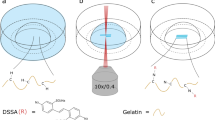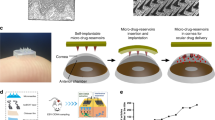Abstract
Here, we describe a simple protocol for the design and construction of a laser-guided direct writing (LGDW) system able to micropattern the self-assembly of liver sinusoid-like structures with micrometer resolution in vitro. To the best of our knowledge, LGDW is the only technique able to pattern cells “on the fly” with micrometer precision on arbitrary matrices, including soft gels such as Matrigel. By micropatterning endothelial cells on Matrigel, one can control the self-assembly of vascular structures and associated liver tissue. LGDW is therefore uniquely suited for studying the role of tissue architecture and mechanical properties at the single-cell resolution, and for studying the effects of heterotypic cell–cell interactions underlying processes such as liver morphogenesis, differentiation and angiogenesis. The total time required to carry out this protocol is typically 7 h.
This is a preview of subscription content, access via your institution
Access options
Subscribe to this journal
Receive 12 print issues and online access
$259.00 per year
only $21.58 per issue
Buy this article
- Purchase on Springer Link
- Instant access to full article PDF
Prices may be subject to local taxes which are calculated during checkout






Similar content being viewed by others
References
Zakim, D. & Boyer, T. Hepatology: A Textbook of Liver Disease 3rd edn., Vol. 1 (WB Saunders Company, Philadelphia, PA, 1996).
Desmet, V.J. in The Liver, Biology and Pathobiology 4th edn. (ed. Arias, I.M.) 3–15 (Lippincott Williams & Wilkins, Philadelphia, PA, 2001).
Taub, R. Liver regeneration: from myth to mechanism. Nat. Rev. Mol. Cell Biol. 5, 836–847 (2004).
Nedredal, G.I. et al. Liver sinusoidal endothelial cells represents an important blood clearance system in pigs. Comp. Hepatol. 2, 1 (2003).
Willekens, F.L.A. et al. Liver Kupffer cells rapidly remove red blood cell-derived vesicles from the circulation by scavenger receptors. Blood 105, 2141–2145 (2005).
Behnia, K. et al. Xenobiotic metabolism by cultured primary porcine hepatocytes. Tissue Eng. 6, 467–479 (2000).
Grattagliano, I., Portincasa, P., Palmieri, V.O. & Palasciano, G. Overview on the mechanisms of drug-induced liver cell death. Ann. Hepatol. 1, 162–168 (2002).
Dahn, M.S., Lange, M.P. & Berberoglu, E.D. Functional characteristics of the hypermetabolic isolated perfused liver. Shock 6, 52–56 (1996).
Lee, K., Berthiaume, F., Stephanopoulos, G.N. & Yarmush, M.L. Profiling of dynamic changes in hypermetabolic livers. Biotechnol. Bioeng. 83, 400–415 (2003).
Ramadori, G. & Christ, B. Cytokines and the hepatic acute-phase response. Semin. Liver Dis. 19, 141–155 (1999).
Ankoma-Sey, V. Hepatic regeneration—revisiting the myth of prometheus. News Physiol. Sci. 14, 149–155 (1999).
Michalopoulos, G.K. & DeFrances, M.C. Liver regeneration. Science 276, 60–66 (1997).
Popovic, J.R. & Kozak, L.J. National Hospital Discharge Survey: Annual summary, 1998. National Center for Health Statistics. Vital Health Stat. 13. 148, 1–194 (2000).
Yarmush, M.L. et al. Hepatic tissue engineering. Development of critical technologies. Ann. NY Acad. Sci. 665, 238–252 (1992).
Tsiaoussis, J., Newsome, P.N., Nelson, L.J., Hayes, P.C. & Plevris, J.N. Which hepatocyte will it be? Hepatocyte choice for bioartifical liver support systems. Liver Tansplant. 7, 2–10 (2001).
Matsumoto, K., Yoshitomi, H., Rossant, J. & Zaret, K.S. Liver organogenesis promoted by endothelial cells prior to vascular function. Science 297, 559–563 (2001).
Fondevila, C., Busuttil, R.W. & Kupiec-Weglinski, J.W. Hepatic ischemia/reperfusion injury—a fresh look. Exp. Mol. Pathol. 74, 86–93 (2003).
Neubauer, K., Saile, B. & Ramadori, G. Liver fibrosis and altered matrix synthesis. Can. J. Gastroenterol. 15, 187–193 (2001).
Gardner, J.P. et al. L-SIGN (CD 209L) is a liver-specific capture receptor for hepatitis C virus. Proc. Natl. Acad. Sci. USA 100, 4498–4503 (2003).
Jayaraman, A., Yarmush, M.L. & Roth, C.M. Evaluation of an in vitro model of hepatic inflammatory response by gene expression profiling. Tissue Eng. 11, 50–63 (2005).
Balis, U.J. et al. Oxygen consumption characteristics of porcine hepatocytes. Metab. Eng. 1, 49–62 (1999).
Foy, B.D., Rotem, A., Toner, M., Tompkins, R.G. & Yarmush, M.L. A device to measure the oxygen uptake rate of attached cells: importance in bioartificial organ design. Cell Transplant. 3, 515–527 (1994).
Griffith, L.G. & Naughton, G. Tissue engineering—current challenges and expanding opportunities. Science 295, 1009–1016 (2002).
Nahmias, Y., Schwartz, R.E., Wei-Shou, H., Verfaillie, C.M. & Odde, D.J. Endothelium-mediated hepatocyte recruitment in the establishment of liver-like tissue in vitro. Tissue Eng. 12, 1627–1638 (2006).
Bhatia, S.N., Balis, U.J., Yarmush, M.L. & Toner, M. Probing heterotypic cell interactions: hepatocyte function in microfabricated co-cultures. J. Biomater. Sci. Polym. Ed. 9, 1137–1160 (1998).
Bhatia, S.N., Balis, U.J., Yarmush, M.L. & Toner, M. Effect of cell–cell interactions in preservation of cellular phenotype: cocultivation of hepatocytes and nonparenchymal cells. FASEB J. 13, 1883–1900 (1999).
Goulet, F., Normand, C. & Morin, O. Cellular interactions promote tissue-specific function, biomatrix deposition and junctional communication of primary cultured hepatocytes. Hepatology 8, 1010–1018 (1988).
Nahmias, Y., Casali, M., Barbe, L., Berthiaume, F. & Yarmush, M.L. Liver endothelial cells promote LDL-R expression and the uptake of HCV-like particles in primary rat and human hepatocytes. Hepatology 43, 257–265 (2006).
Ito, Y., Bethea, M.W., Abril, E.R. & McCuskey, R.S. Early hepatic microvascular injury in response to acetaminophen toxicity. Microcirculation 10, 391–400 (2003).
Nahmias, Y.K., Gao, B.Z. & Odde, D.J. Dimensionless parameters for the design of optical traps and laser guidance systems. Appl. Opt. 43, 3999–4006 (2004).
Nahmias, Y., Schwartz, R.E., Verfaillie, C.M. & Odde, D.J. Laser-guided direct writing for three-dimensional tissue engineering. Biotechnol. Bioeng. 92, 129–136 (2005).
Odde, D.J. & Renn, M.J. Laser-guided direct writing for applications in biotechnology. Trends Biotechnol. 17, 385–389 (1999).
Odde, D.J. & Renn, M.J. Laser-guided direct writing of living cells. Biotechnol. Bioeng. 67, 312–318 (2000).
Kubota, Y., Kleinman, H.K., Martin, G.R. & Lawley, T.J. Role of laminin and basement membrane in the morphological differentiation of human endothelial cells into capillary-like structures. J. Cell Biol. 107, 1589–1598 (1988).
Vernon, R.B., Angello, J.C., Iruela-Arispe, M.L., Lane, T.F. & Sage, E.H. Reorganization of basement membrane matrices by cellular traction promotes the formation of cellular networks in vitro. Lab. Invest. 66, 536–547 (1992).
Nahmias, Y.K. & Odde, D.J. Analysis of radiation forces in laser trapping and laser-guided direct writing applications. IEEE J. Quantum Electron. 38, 131–141 (2002).
Neuman, K.C., Chadd, E.H., Liou, G.F., Bergman, K. & Block, S.M. Characterization of photodamage to Escherichia coli in optical traps. Biophys. J. 77, 2856–2863 (1999).
Liang, H. et al. Wavelength dependence of cell cloning efficiency after optical trapping. Biophys. J. 70, 1529–1533 (1996).
Renn, M.J. & Pastel, R. Particle manipulation and surface patterning by laser guidance. J. Vacuum Sci. Technol. B 16, 3859–3863 (1998).
Renn, M.J. et al. Laser-guided atoms in hollow-core optical fibers. Phys. Rev. Lett. 75, 3253–3256 (1995).
Cleaver, O. & Melton, D.A. Endothelial signaling during development. Nat. Med. 9, 661–668 (2003).
LeCouter, J. et al. Angiogenesis-independent endothelial protection of liver: role of VEGFR-1. Science 299, 890–893 (2003).
Lammert, E., Cleaver, O. & Melton, D. Induction of pancreatic differentiation by signals from blood vessels. Science 294, 564–567 (2001).
Dunn, J.C.Y., Tompkins, R.G. & Yarmush, M.L. Long-term in vitro function of adult hepatocytes in a collagen sandwich configuration. Biotechnol. Prog. 7, 237–245 (1991).
Narmoneva, D.A., Vukmirovic, R., Davis, M.E., Kamm, R.D. & Lee, R.T. Endothelial cells promote cardiac myocyte survival and spatial reorganization: implications for cardiac regeneration. Circulation 110, 962–968 (2004).
Akselrod, G.M. et al. Laser-guided assembly of heterotypic three-dimensional living cell microarrays. Biophys. J. 91, 3465–3473 (1006).
Ho, C.-T., Lin, R.-Z., Chang, W.-Y., Chang, H.-Y. & Liu, C.-H. Rapid heterogeneous liver-cell on-chip patterning via the enhanced field-induced dielectrophoresis trap. Lab Chip 6, 724–734 (2006).
Author information
Authors and Affiliations
Corresponding author
Ethics declarations
Competing interests
The authors declare no competing financial interests.
Rights and permissions
About this article
Cite this article
Nahmias, Y., Odde, D. Micropatterning of living cells by laser-guided direct writing: application to fabrication of hepatic–endothelial sinusoid-like structures. Nat Protoc 1, 2288–2296 (2006). https://doi.org/10.1038/nprot.2006.386
Published:
Issue Date:
DOI: https://doi.org/10.1038/nprot.2006.386
This article is cited by
-
3D Co-Culture with Vascular Cells Supports Long-Term Hepatocyte Phenotype and Function In Vitro
Regenerative Engineering and Translational Medicine (2018)
-
Selective pattern of cancer cell accumulation and growth using UV modulating printing of hydrogels
Biomedical Microdevices (2015)
-
Patterned prevascularised tissue constructs by assembly of polyelectrolyte hydrogel fibres
Nature Communications (2013)
-
Cell trapping and patterning using dielectric-structure-assisted negative dieletrophoresis
Science China Technological Sciences (2013)
-
Microscale methods to assemble mammalian cells into tissue-like structures
Science China Life Sciences (2012)
Comments
By submitting a comment you agree to abide by our Terms and Community Guidelines. If you find something abusive or that does not comply with our terms or guidelines please flag it as inappropriate.



